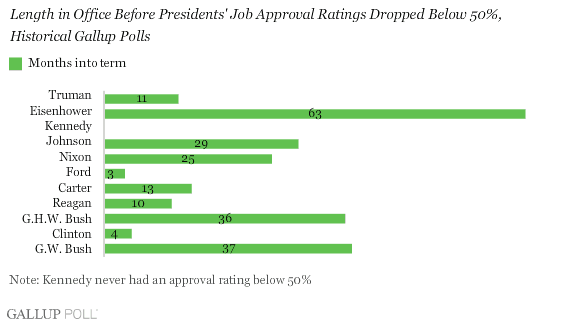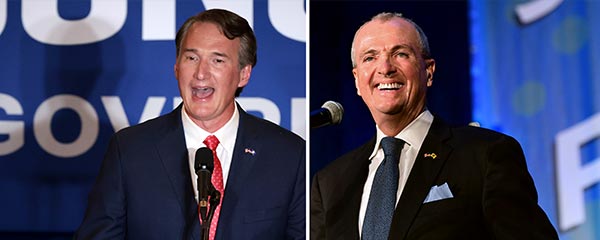PRINCETON, NJ -- Barack Obama's latest job approval rating is 51%, according to Aug. 23-25 ���۴�ýDaily tracking. [AUTHOR'S NOTE: Obama's job approval rating has fallen to since this story was originally published.] Should his rating continue its downward trend and fall below 50%, he would -- like most post-World War II presidents -- have less-than-majority approval at some point in his presidency. However, Obama, in his eighth month in office, could hit this mark in a shorter time than has typically been the case. If his rating falls below 50% before November, it would represent the third-fastest drop to below majority approval since World War II, behind the declines for Gerald Ford (in his third month as president) and Bill Clinton (in his fourth month).

The time it has taken for presidents' approval ratings to drop below 50% has varied greatly.
-
Dwight Eisenhower did not fall below the majority level until his fifth year in office, and his 48% approval rating in March and April 1958 was his only sub-50% approval rating.
-
Both George Bushes were in office roughly three full years before their approval ratings slid below 50%. The younger Bush might have gotten there much faster if not for the post-Sept. 11 rally, as his approval rating just before the terror attacks was 51%, but it shot up to 86% days later.
-
Lyndon Johnson and Richard Nixon both served more than two years in office before their approval ratings fell below 50%.
-
Four presidents -- Harry Truman (11 months into his term), as well as Ford, Reagan, and Clinton -- dropped below majority approval in their first year in office.
-
Jimmy Carter had relatively high early approval ratings and did not drop below 50% approval until February 1978, after a year in office.
-
John Kennedy never had a sub-50% approval rating in his less-than-three-year term, though his ratings were on a downward trend at the time of his untimely death.
Excluding Kennedy's presidency, the average amount of time before a president lost majority approval is 23 months. The typical or median length is 13 months.
Ford's quick descent to below-majority approval was hastened by his unpopular decision to pardon Nixon in September 1974. Clinton also suffered from a series of missteps in attempting to change policy (gays in the military), fill positions within his administration (failed nominees Zoe Baird, Kimba Wood, and Lani Guinier), and controversy over a haircut he received aboard Air Force One at Los Angeles International Airport.
Obama began his term with . His six-month honeymoon was slightly below average in length compared to those of other elected presidents in recent times. The recent further erosion in his public support -- perhaps a result of the push for healthcare reform and concern over the growth in government spending -- may result in one of the faster slides below majority approval for modern presidents.
However, falling below 50% would hardly mark a point of no return for Obama. All presidents went back above the 50% mark after their initial loss of majority public support. And Clinton and Reagan, who dropped below majority approval faster than most other presidents, easily won second terms in the subsequent election.
Survey Methods
Results are based on telephone interviews with 1,529 national adults, aged 18 and older, conducted Aug. 23-25, 2009, as part of ���۴�ýDaily tracking. For results based on the total sample of national adults, one can say with 95% confidence that the maximum margin of sampling error is ±3 percentage points.
Interviews are conducted with respondents on land-line telephones (for respondents with a land-line telephone) and cellular phones (for respondents who are cell-phone only).
In addition to sampling error, question wording and practical difficulties in conducting surveys can introduce error or bias into the findings of public opinion polls.
